It’s likely that more bike trips happen in Bogotá, Colombia, than any other city in the Western Hemisphere.
With 8.8 million residents — a number that has grown by about 12,000 every month for the last 50 years — Bogotá’s estimated 4 percent of trips by bike makes it approximately as bikey as the Portland metro area (2.2 million, with about 2.2 percent of commutes by bike) but much, much bigger.
So I was pretty pleased with the fact that my wife was as excited as I was about going there for our honeymoon. Here’s a tip, fellow nerds: don’t tell your traveling partner quite how many photos of infrastructure you think it’s appropriate to take until you’re actually on the trip.
Here’s a second tip: if, after failing to have this conversation, you still happen to have a traveling partner as cool and patient as mine was, make sure they have something to read.
(Confidential to Mo: I owe you at least one Kindle purchase.)
In any case, our 20-day trip in July to Bogotá and the other Colombian cities of Medellín, Cartagena and Campurgana — my first trip anywhere south of Mexico! — led to two posts worth of observations. This one is the first: just a series of photos of Colombians getting around Medellin and Bogota on bikes.
Though these were taken with an iPhone and aren’t as nice as Jonathan’s occasional “People on Bikes” series, we’ll use that name because the goal is similar: to capture a little slice of how people get ready for a bike trip and interact with the world around them while they’re riding.
1
2
3
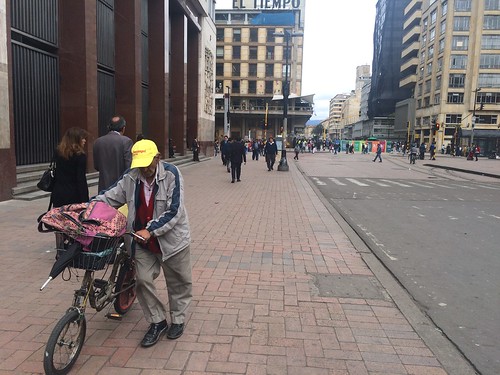
4
As you can see, a lot of these photos are from the ciclorutas, the city’s 200-mile network of protected bike lanes. Built over the last 15 years, these are allegedly inspired by Dutch design but are a very different beast. In most cases (though not all) they were carved out of the onetime pedestrian space and their width and curb cuts (or sometimes lack thereof) aren’t particularly well-suited to biking — certainly not at any high speed. They rarely do a great job of separating bike and foot traffic.
And though I’m sure we’d have learned the routes quickly if we needed to, we lost their course several times because they weren’t very well connected, signed or otherwise marked.
But here’s the thing: without them, biking in Colombia would be horrific by U.S. standards. That’s because, like almost every other country in the world, Colombia has gradually handed over most of its street space to anyone who can afford to drive a car. The shot below shows one of the many huge arterials in Medellín that offer lane after lane to motor vehicles and let people biking fend for themselves.
5
In the context of current Colombian traffic culture, it would be ridiculous to expect people to avoid driving in a painted bike lane, let alone for people driving to give bikers the thoughtfully wide berths that are (thankfully) common on Portland streets. Basically, the only way to bring biking up to a Portland level of comfort is to build protected bike lanes.
Which makes it all the more impressive, really, that that’s exactly what Bogotá and (to a lesser extent) Medellín have been doing. And their residents have certainly taken advantage of it.
6
7
8
9
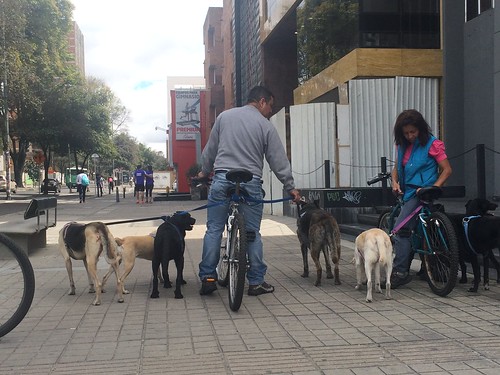
I’m not sure if this couple do this for a living or just really like dogs. Or both.
10
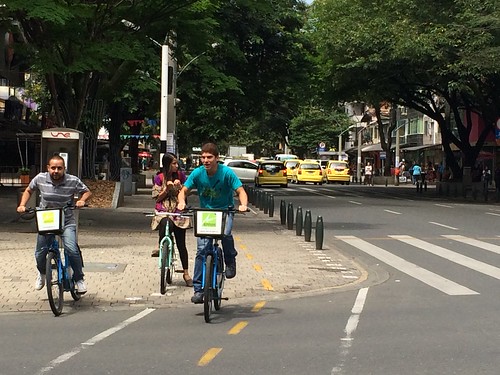
One thing that keeps these low-budget protected bike lanes more comfortable than they might be, at least in some parts of the cities, is the relatively pointy street corners. I sat alongside the corner below for a few minutes and watched every single car that turned right slow to 15 mph or less, thanks to the short turning radius built into the pavement. (Also note that in this particular intersection, there’s barely enough space for a car to hang out mid-turn without obstructing the vehicles behind it — it’s not a protected intersection but it’s getting there.)
11
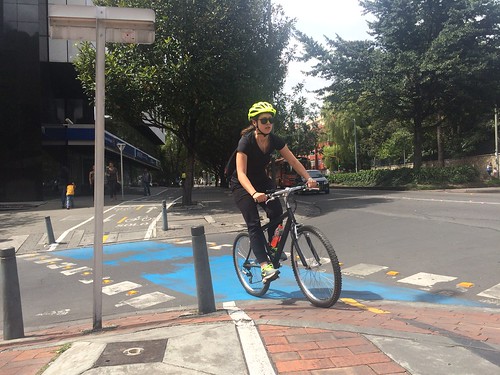
12

13
Advertisement
14

This bidirectional lane in a run-down area was pretty empty most of the time. Notice that it doubles as public seating (and sometimes car parking).
15
16
17
18
18
Like other leading bike cities I could mention, Bogota has been slow to create a bike sharing system. (It does have some sort of stripped-down system, with various rental locations staffed by public employees, that I never quite figured out.) That’s not the case in Medellín, which prides itself on being generally ahead of Colombia’s curve. Its system is called Encicla:
19
20
21
Some of these photos were taken during ciclovía, the open-streets tradition that began in Bogotá in the 1970s and has spread through much of the Americas, including to Portland. Bogotá holds it every Sunday, and hundreds of thousands of Bogotanos turn out every week to savor the temporarily calm streets.
22
23
24
This guy’s big sign says “Around the world for ecology and conscience” in Spanish.
25
26
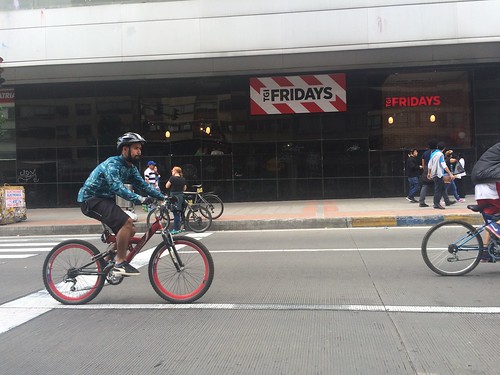
Like quite a few streets in central Bogotá and Medellín, Carrera 7 has been fully pedestrianized during most hours in the city center. There’s still a planter-protected bike lane there, but people don’t pay much attention to it. (In fact it’s sort of an annoying street to bike on, especially during ciclovía, exactly because it’s such a fantastic place to walk.)
27
28
OK, that’s your starter kit to Colombian streets. Tomorrow, I’ll share some photos that take a broader look at these Colombian cities and draw a few lessons that Portlanders and other estadounidenses should be learning from them.


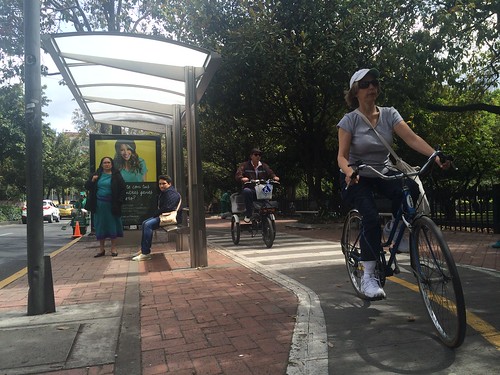
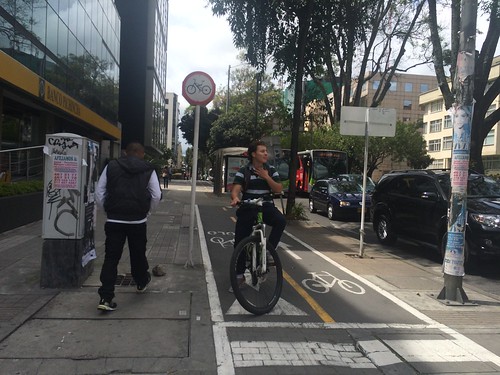

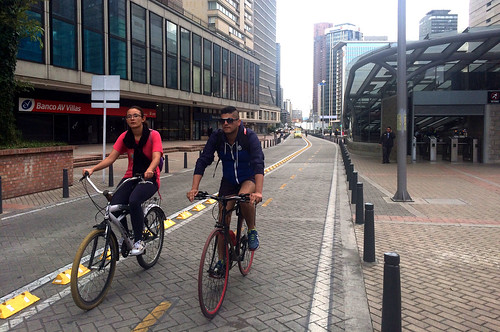

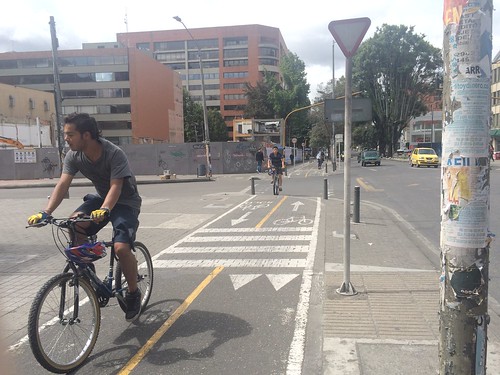



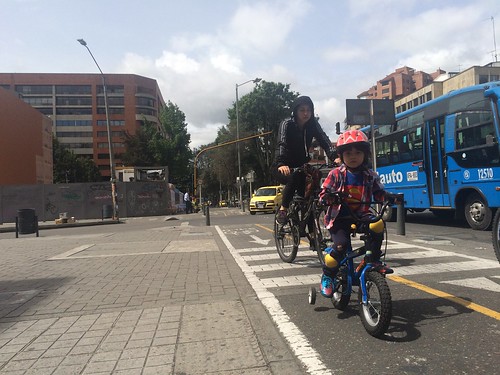
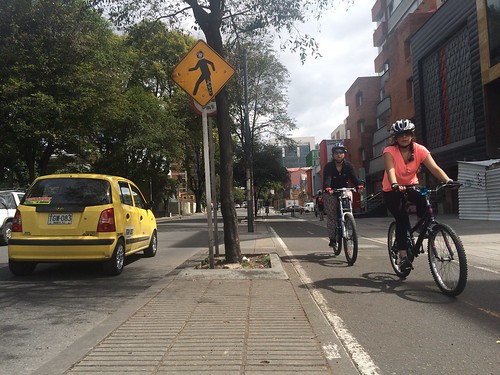

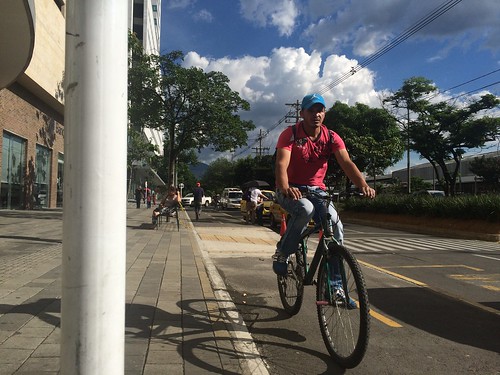
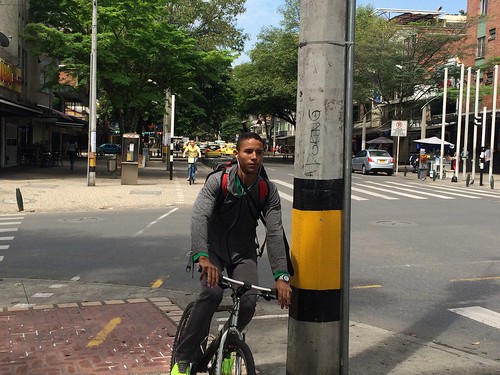

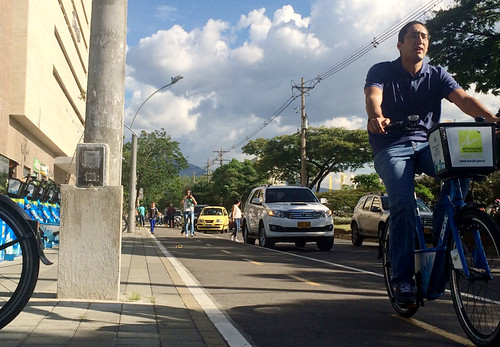
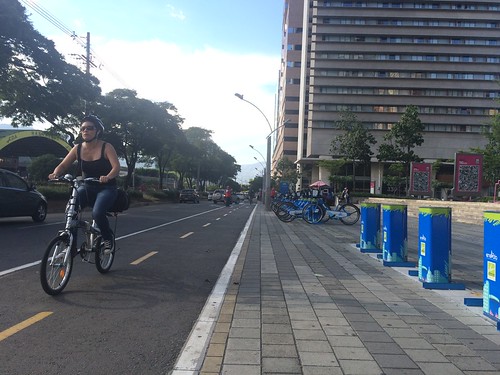
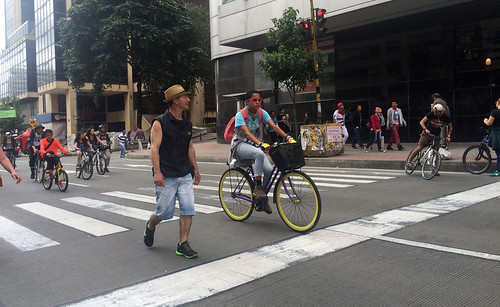
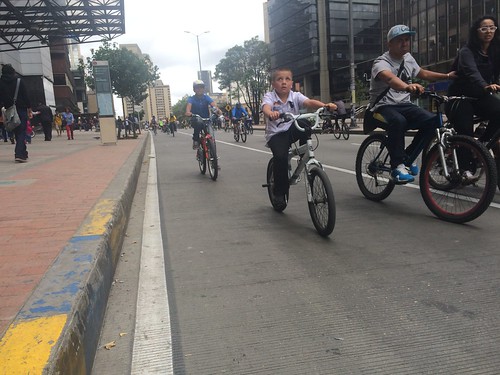

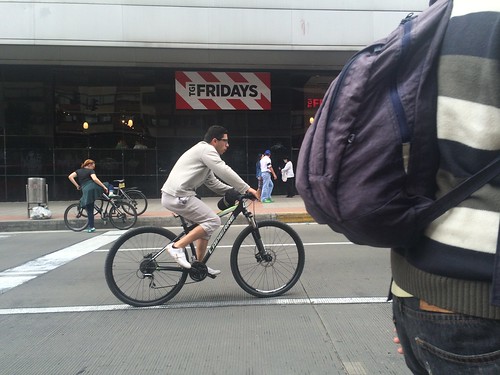

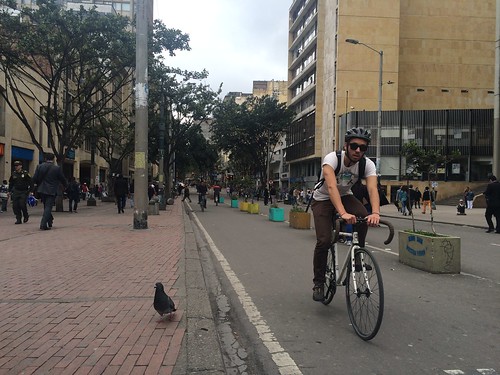




Thanks for reading.
BikePortland has served this community with independent community journalism since 2005. We rely on subscriptions from readers like you to survive. Your financial support is vital in keeping this valuable resource alive and well.
Please subscribe today to strengthen and expand our work.
Nice to see such a positive posting about Columbia, considering the drug-related crime reputation.
That was 20 years ago. Now the crime related drug reputation belongs to Chicago. Colombia is now very safe and has been for years. Huge amounts of Foreign Direct Investment, tourism, growth and stability.
Hey Curtis, it’s not 1989 anymore. Colombia has moved on, so should you.
From the state department as of 2015: “The Department of State strongly encourages U.S. citizens to exercise caution and remain vigilant as terrorist and criminal activities remain a threat throughout the country. Explosions occur throughout Colombia on a regular basis, including in Bogota.”
http://travel.state.gov/content/passports/english/alertswarnings/colombia-travel-warning.html
We know they know what they’re talking about since they feel it is acceptable to sign a deal allowing Iran to get a nuke in a few years. Laughable.
To be fair, Columbia does have a gun fatality rate roughly 3x the US (which is already insanely high).
https://en.wikipedia.org/wiki/List_of_countries_by_firearm-related_death_rate
Regarding the Iran comment, my only advice would be to lay off the right-wing propaganda.
Thank you for going on the record that it is OK for Iran to have a nuke. Stating facts is not “propaganda”.
On your gun fatality rate propaganda, Colombia has a gun homicide rate 7.6x that of the US per your own table. If you count suicides then the number is only 3x as you indicated. I don’t worry much about suicides in gun statistics – if someone wants to kill themselves they are going to do it one way or another. AND if you remove the gang shootings caused by liberal policies in big cities the US rate would drop by a factor of 4 or 5 – thus if you just stay out of the “wrong” areas you are fairly safe in the US:
https://www.reddit.com/r/Firearms/comments/23k9ju/80_of_gunrelated_deaths_nonsuicide_are_gang/
😉
#24!
If my rusty Spanish is still intact, then the triangular sign on his hat says “Trash is not what is lying on the ground, ‘trash’ is he who throws it there”.
When I went to Bucaramanga, Colombia, I had never seen so many cyclists. And I used to live in Durango, CO. Very active, big cycling community. Colombia is actually fantastic, albeit there are still some areas of the country to avoid. But the people are awesome and the country is incredibly beautiful.
Some, but not a lot of helmet use… Noticed the younger riders in particular don’t seem to be wearing them.
Here in slovakia we have all ages law on streets outside cities and villages (except field/forest roads) and police enforce it strictly in some areas but in other no. The fine is 13$. What i see on cat. 1 roads with heavy traffic almost all wear helmets and many also reflector strips what i think is right so. But on village roads and especially segregated cycle paths many flouting the law. In cities and villages most people dont wear helmets. In city limits only lycra wearers and cyclists who come outside villages wear helmets. In cities with many bike commuters one in 10 cyclists wear helmets. Now every city build new segregated cycle paths and also outside cities. They now allocate eu funds so its possible 1000 km new cycle paths in cities to 2020. Also every bigger city improves bike sharing. And the number of bike commuters grows. So will be slovakia the next holland?
Not a single lycra-clad roadie in there!
Funny how rare those are in the places with higher ridership numbers.
I did see a few during ciclovia, though just a few.
26 photos and only 2 bikes with drop bars…..hummm seeing a trend here.
I love Columbia. I’m thinking of going soon for classes. How was the food/culture/experience?
Food: meh. It was cheap (at least on today’s dollars) but not the highlight, at least for me. I’d describe Colombian food as simple and straightforward. Not enough vegetables in the diet for my taste. We did go to a couple spendy restaurants (for the price of a nice-but-not-special-occasion restaurant in Portland) and they were fantastic.
Culture: fascinating. Like the USA it seemed to have both strong regional identity and strong national identity. For somebody who’s obsessed with localism, that’s pretty cool. I read the Great Colombian Novel, One Hundred Years of Solitude, for the first time while we were there and that was a wonderful experience too.
Experience: get there soon! The world is gradually discovering it.
Wow, couldn’t be jealous of your trip to Colombia. Can’t wait to see more. One thing I noticed in the pics and, have been told about, is the air quality can be tough in Colombian cities. I hope they go as nuts with this stuff as the Dutch have.
super-high altitude makes air quality worse, but it’s not bad.
Some of that is just camera-without-white-balance haze. But yes, the air quality is certainly worse than Portland’s.
Meant to say couldn’t be *more* jealous of your trip to Colombia.
Nicely done, representative photos.
That’s real dedication, urban biking in Colombia on your honeymoon, vs. zooming down Haleakala on Maui!
Paul, have you biked down Haleakala? I’m going in February and it’s on my list of potential things to do. Interested if you have any input on the ride.
My only advice on that ride: Don’t Mistake Aloha for Weakness.
always great to see the bicycling movement is a global issue which even though there are plenty of local setbacks, is continually moving forward to make cities around the world better for bikes.
FYI, Bogota is about 1/3 the physical size of Portland according to Google Earth. Portland metro area dimensions in miles ~ 30 x 23 and Bogota ~ 11 x 21. As stated, the population of Bogota is much larger.
Just out of curiosity, why did you choose to visit there? Relatives in Columbia? AND, we MUST know how you got there – not using fossil fuels we hope.
We have a couple friends from Colombia, and we wanted an affordable place with significantly different culture than ours, good weather in July, a mix of sun and interesting cities, ideally without major time zone changes and with a language we were at least passable in. Turned out to be a short list.
I just wish we’d been able to bike to South America and back in 20 days. We flew.
AH Ha! I figured you must know someone there – or else you’re doing research for bike trails………….or both…..
And I figured you flew. BUT not using fossil fuels is a theme on this website so “you started it” – I’m just giving you a hard time………..
🙂
Portland’s urban area is listed as 145 sq mi on Wikipedia (the source being the Census’s Gazetteer). Bogota’s urban area is given as 118 sq mi.
Here’s Bogota at zoom level 12 in Google Maps/Earth: https://www.google.com/maps/place/4%C2%B035'53.0%22N+74%C2%B004'33.0%22W/@4.656251,-74.0820067,22254m/data=!3m1!1e3!4m2!3m1!1s0x0:0x0?hl=en
And here’s Portland at the same zoom level: https://www.google.com/maps/place/45.5424364,-122.654422,62614m/@45.537048,-122.6967965,15643m/data=!3m1!1e3!4m2!3m1!1s0x0:0x0
Not sure how you get the idea that Bogota is a third the size (that would make it not six times as dense as Portland, but EIGHTEEN TIMES as dense).
It’s spelled Colombia – with an o</b, not a u, no matter what language you’re using.
And Bogota, at over 8,500 feet in elevation (way higher than any US city, it’s very cool to see how so many people are out pumping the pedals. Necessity is the mother of invention, I suppose.
I realized I misspelled Colombia when I hit the button. There are many “towns” in the US that are higher than 8,500′, but no large cities.
Bogota (and the rest of Colombia) is fantastic. I’m kind of happy that the American reputation for it is not great, there aren’t many places that are beautiful and also less than 10 hours away by plane.
Seeing the *weekly* ciclovias is great. The triple-bendy-BRT system is fast and was a wise investment in a country that doesn’t have the capital to build a grand subway system. Most of the improvement happened because of an inspired mayor. Hmm. Does that give you any ideas?
Some questions for M or anyone else who has been recently:
– did you go to Crepes y Waffles? omg.
– do they still have the human phone booths (person with a cell phone on a chain, standing on a street corner)
– how many private buses did you see on the nonprimary routes? When I was there ~8 years ago they were supposed to be removing many of them.
“there aren’t many places that are beautiful and also less than 10 hours away by plane.”
Wow.
missed the “underrated by americans” part when I typed it. That’s where I was headed- hence “kind of happy” in the same sentence
Crepes y Waffles = delicious
Every street vendor was selling mobile minutes, but we didn’t see people just standing in the way you mention.
Private buses = oh yes. Stay tuned.
“Bogota (and the rest of Colombia) is fantastic.”
Maybe, but you need to be careful.
From the US State Department: “U.S. government officials in Colombia regularly travel to the major cities of Colombia such as Bogota, Medellin, Cali, Barranquilla, and Cartagena without incident. U.S. government officials and their families in Colombia normally are permitted to travel to major cities only by air. They may not use inter- or intra-city bus transportation, or travel by road outside urban areas at night.”
http://travel.state.gov/content/passports/english/alertswarnings/colombia-travel-warning.html
As of 2012, Colombia has 12th highest homicide rate of world countries (but there is a war going on): (sort the list by “rate”)
https://en.wikipedia.org/wiki/List_of_countries_by_intentional_homicide_rate
It is getting better – in the 1980s and 90s it had number 1 or 2 highest homicide rate – today it’s down around 10 or 12.
https://en.wikipedia.org/wiki/List_of_countries_by_intentional_homicide_rate_by_decade
It does say the areas visited in this BP article are mostly OK – just stay off the busses.
It’s certainly not for the no-passport/cruise ship crowd. The problems (kidnappings) are for people who are doing Unknown Things In The Jungle and oil company executives. Period. Less than 5% are “tourists”.
Colombia is for the most part full of great people who are a joy to hang out with. The areas to avoid, for the time being, are the Pacific coast from the Darien down past Buenaventura; the border region with Ecuador; parts of border regions in the southeast; and now there’s a crisis going on with Venezuela, where Maduro is booting out Colombians. Also, outside of the major cities, there aren’t many people who speak English. Fortunately I’m fluent in Spanish so I didn’t have a problem, but it would have been really difficult in some places with no English. If you’re prior military, and you want to get off the beaten track, avoid taking any kit, anything that resembles military gear, even if it isn’t/wasn’t. I’m sure you could find a tourist here and there who traveled in these areas and didn’t have any problems, but it’s best not to tempt fate.
You should see what other countries say about the US! With constant mass shootings, riots, out of control police departments, a drug epidemic, and over 30,000 (!) deaths a year on the roads its a wonder Europeans still risk a visit to Disney
Sounds like the US is kind of the opposite of Colombia – our rural “conservative” areas are safer than the “liberal” areas of our big cities. I would definitely advise people to stay away from Chicago, Detroit, Baltimore, St. Louis, North Portland, Nawluns, etc…….places run for the past 60 years by liberals and now very unsafe.
Gotta be careful anywhere in the world today – but that’s always been the case – just need to be more careful in some parts than others.
I still wonder: Why Colombia as a tourist destination? I am sure it’s a beautiful place but it sounds like the author of this post spent most of the time in cities and thus probably didn’t get to see much of the countryside…..perhaps he has family down there………
Why not as a tourist destination? Is it “wrong” to visit cities?
No it’s not wrong; you can do what you want – but usually there is a “reason” for flying that far away. I’m just used to people going somewhere to do something you can’t do here – like climb a particular mountain, raft a particular river, watch Juan Valdes grow coffee, watch a Colombian war, or see exotic animals, etc. 🙂
BUT MA explained above – they have friends there – that’s a common reason to go somewhere.
I know it should have been a z.
🙂
Ah yeah, nothing says “welcome tourists” like the conservative paradise of the mississippi swamps or the florida panhandle where you can get shot if your car is pink.
I find it quite sad how you only see the world in the liberals vs conservatives way, with blinders on.
Never been to those places but I think both are popular with tourists.
I’m just giving you some “stuff” in reply to your comment. It’s entertaining to poke fun at liberals, by stating the truth and then watching them squirm, but you are correct that the US is probably viewed poorly by many – our liberal cities are giving us a bad name on the violence front. Sad for sure. There I go again. 🙂
BUT the EU has over 25,000 traffic deaths per year, so they are not doing so great either:
http://etsc.eu/9th-annual-road-safety-performance-index-pin-report/
AND I’ll bet they have a drug problem just like ours. AND they are having a huge illegal immigrant problem similar to ours………
The only person I know who has ever been shot at had it happen in rural SE Oregon. Guess they don’t like outsiders in those conservative rural areas…
What was that person doing to get shot at?
🙂
I can’t recall anyone I know who was shot at by someone who intended to hit them. And I’m old and have spent lots of time in rural and urban areas. Lucky I guess.
On another note, the biggest take-away should be the can-do attitude you see in Latin America.
We should build a cycle track = done. Maybe not the best design or materials, but money is much tighter. Same with BRT. We need BRT = done.
Meanwhile, in the US, we have extra money so we throw it into 15 years of studies to get 1/20 of the network and then bitch and moan because a detail is wrong so we should never do it again.